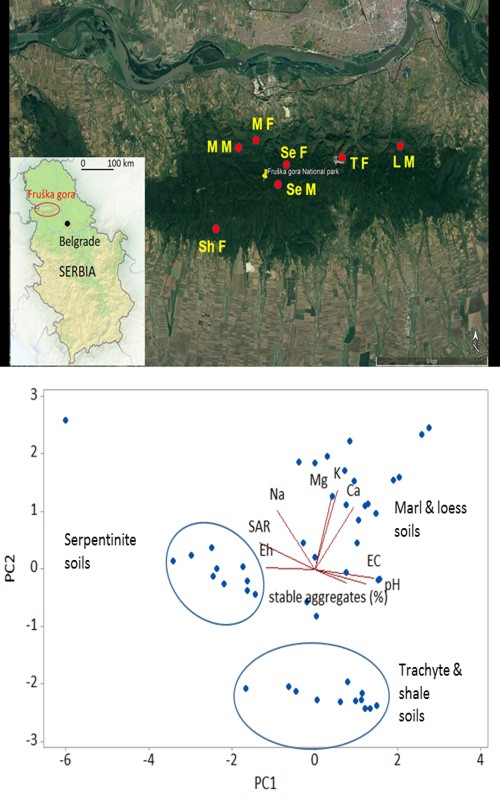The influence of geological setting and land use on the physical and chemical properties of the soil at the Fruška Gora Mountain Scientific paper
Main Article Content
Abstract
Soil erosion is a problem that affects the landscape at different scales and represents a serious challenge for land management and soil conservation in both natural forests and meadows. The aim of this study was to determine how the parent material and land use affect the physical and chemical properties of the soil in the area of the Fruška Gora Mountain. The soils were separated into five bedrock types: serpentinite, marl, trachyte, shale, loess and two land use types: forest and meadow. Twenty-three forest soil and 24 meadow soil from a depth of 0–20 cm were sampled from the Fruška Gora Mt. The following properties were determined: pH, electrical conductivity, oxidation-reduction potential, content of organic carbon, sodium adsorption ratio, aggregate size and stability. There is no statistically significant difference in pH values, redox potential (Eh), electrical conductivity (EC) and sodium adsorption ratio (SAR) values between the analysed forest and meadow soils, but there is a statistically significant difference in the content of organic carbon (Corg). It can be concluded that both the parent material, and to a slightly less extent, land use have a great influence on physico-chemical properties of the soil.
Downloads
Metrics
Article Details

This work is licensed under a Creative Commons Attribution-NonCommercial-NoDerivatives 4.0 International License.

Authors retain copyright and grant the journal right of first publication with the work simultaneously licensed under a Creative Commons Attribution license 4.0 that allows others to share the work with an acknowledgement of the work's authorship and initial publication in this journal.
Funding data
-
Ministarstvo Prosvete, Nauke i Tehnološkog Razvoja
Grant numbers 451-03-47/2023-01/2000
References
D. Karlen, M. Mausbach, J. Doran, R. Cline, R. Harris, and G. Schuman, Soil Sci. Soc. Am. J. 61 (1997) 4 (https://doi.org/10.2136/sssaj1997.03615995006100010001x)
J. Haas, H. Schack-Kirchner, and F. Lang, Eur. J. For. Res. 139 (2020) 549 (https://doi.org/10.1007/s10342-020-01269-5)
R. Raison, P. Khanna, in Soil Health and Climate Change, B. P. Singh, A. L. Cowie, K. Y. Chan, Eds., Springer, Berlin, 2011, pp. 257–285, ISBN: 978-0-12-818032-7 (https://doi.org/10.1007/978-3-642-20256-8_12)
S. Stanchi, G. Falsone, and E. Bonifacio, Solid Earth 6 (2015) 403 (https://doi.org/10.5194/se-6-403-2015)
B. Wang, F. Zheng, M. J. M. Römkens, and F. Darboux, Geomorphology 187 (2013) 1 (https://doi.org/10.1016/j.geomorph.2013.01.018.M)
M. Kasanin-Grubin, E. Hukic, M. Bellan, K. Bialek, M. Bosela, L. Coll, M. Czacha¬row-ski, G. Gajica, F. Giammarchi, E. Gömöryová, M. del Rio, L. Dinca, S. Đogo Mračević, M. Klopčić, S. Mitrović, M. Pach, D. Randjelović, R. Ruiz-Peinado, J. Skrzyszewski, J. Orlić, S. Štrbac, S. Stojadinović, G. Tonon, T. Tosti, E. Uhl, G. Veselinović, M. Vese¬li-nović, T. Zlatanov, R. Tognetti, Can. J. For. Res. 51 (2021) (https://doi.org/10.1139/cjfr-2020-0361)
A. Cerda, Soil Till. Res. 57 (2000) 159 (https://doi.org/10.1016/S0167-1987(00)00155-0)
V. Ćirić, M. Manojlović, Lj. Nešić, M. Belić, J. Soil Sci. Plant Nutr. 12 (2012) 689 (http://dx.doi.org/10.4067/S0718-95162012005000025)
M. Al-Kaisi, in Proceedings of the Integrated Crop Management Conference, Digital Repository of Iowa State University of Science and Technology, Ames, IA, 2001, p. 55 (https://doi.org/10.31274/icm-180809-676)
M. Manojlović, V. Aćin, Letopis naučnih radova 31 (2007) 187 (https://scindeks.ceon.rs/article.aspx?artid=0546-82640701187M) in Serbian
Z. Jiang, H. Liu, H. Wang, J. Peng, J. Meersmans, S. M. Green, T. A. Quine, X.Wu, Z. Song, Nat. Commun. 11 (2020) 2392 (https://doi.org/10.1038/s41467-020-16156-1)
P. Rengasamy, R.S.B. Greene, G.W. Ford, A.H. Mehanni, Aust. J. Soil Res. 22 (1984) 413 (https://doi.org/10.1071/SR9840413).





